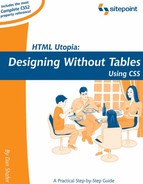Preface
I was already in my 50s when the World Wide Web burst upon the scene. Having spent most of my life to that point as a writer and editor, I naturally gravitated to the publishing side of the coin, rather than remaining content to be an amazed consumer of all the wonderful information and connections that began to flow from it.
As I saw the first version of the first graphical Web browser before it was officially released, some might say I've been there from the beginning. And one thing that bothered me from that beginning, as an author and publisher, was the inability to disentangle content from presentation. The interconnectedness of it all meant that, to produce a Website, you needed not only something to say, and some graphical designs to make the site look good, but you also needed to be a bit of a programmer. Initially, this "programming" was a pretty lightweight task to someone like me who had a broad but thin programming background. HTML markup, when all was said and done, wasn't really programming. Still, it was more than just writing words. And it was more than using a word processor to format words.
Designers who had clear ideas of how they wanted their Web pages to look were frustrated and stymied by the need to create complex sets of deeply nested tables even to approximate their visions. And, as designers came up with increasingly complex ideas, and Web browsers diverged further and further from standards and compatibility, the Web threatened to collapse under its own weight. Serious designers began lobbying for a complete break from HTML to some new approach to the Web. Chaos reigned.
I was at CNET's Builder.com at the time, chronicling all of this, as well as participating in it both as a designer and as a pundit. I was one of the founding members of the Web Standards Project, or WaSP, and I helped found the major conference where Web designers and creators gathered at Builder.com Live! in New Orleans. So I had a front-row seat as we gradually figured out the best way to deal with this problem.
The Holy Grail of the Web, then, was the notion that authors should write, designers should design (and code HTML) and programmers should… well… program. Those boundaries were not clean in the first few years of the Web.
Then, along came Cascading Style Sheets (CSS), the subject of this book. The governing forces of the Web, through the World Wide Web Consortium, better known as the W3C , addressed the problem and proposed that we divide presentation instructions, and structural markup with content, into two separate kinds of files.
Things haven't been the same since, thank goodness! Now we really can (mostly) separate what we say from how it gets presented to the user in a Web browser. I wager that most Web developers today are fairly comfortable with CSS and would no more think of embedding presentation instructions in their HTML than they'd consider mixing 23 fonts on the same Web or print page.
Since CSS emerged, there have been dozens of books written about it. So when SitePoint approached me about doing a CSS book, my first thought was, "Who needs another CSS book?" But as they began to reveal their vision to me, it made sense. It was indeed time for a book that took a different tack, based on the extensive experience of the Web design community.
So, this book is different in two primary ways.
First, it focuses on the question of how to accomplish with CSS some of the successes Web designers have spent significant time and energy to create using nested tables. Said another way, this book doesn't try to start from scratch and become a CSS tutorial. Instead, it's a sort of introductory CSS design guide.
Second, it starts at the outside and works its way in. Most, if not all, other CSS books, focus first on the little pieces: the attributes, values, and tags that comprise the syntax of CSS. They then explain how to put those pieces together into a Website.
This book begins by looking at how CSS should influence the entire design of a site, and how to put the CSS framework in place before you begin to deal with individual HTML elements and their styling.
